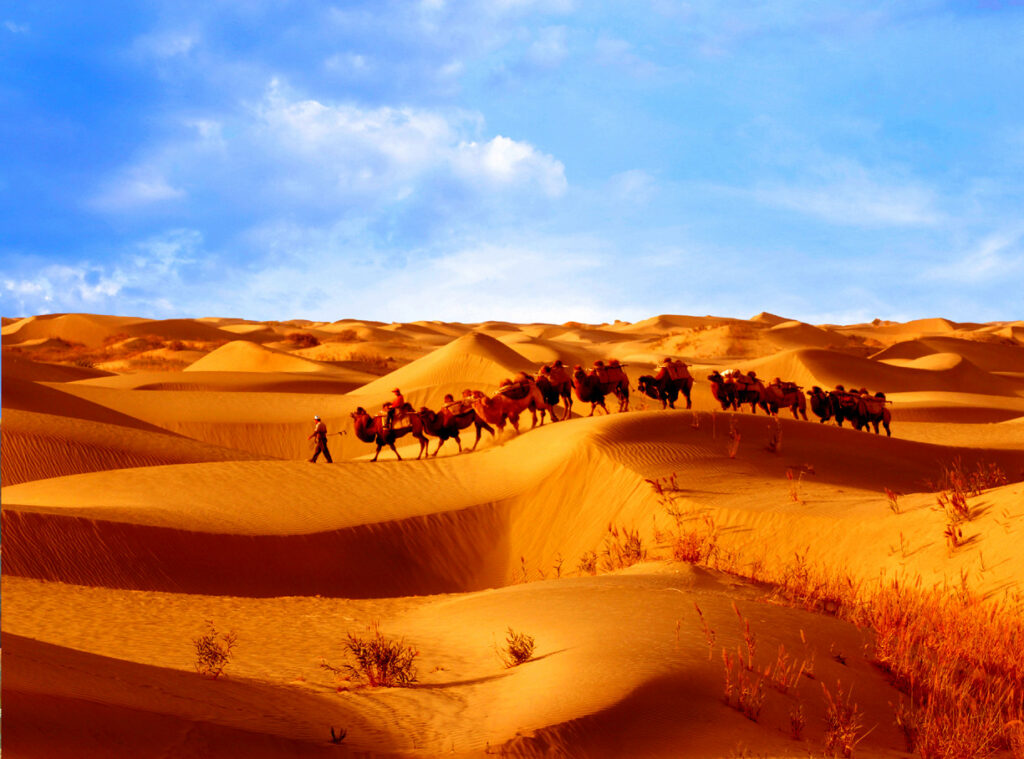
中国新疆维吾尔自治区地处中国西北,位于亚欧大陆腹地,”丝绸之路”在此将古代中国与世界联系起来,使其成为多种文明的交流荟萃之地。 历史上的新疆一直是多民族聚居地区,自汉代开始,新疆地区正式成为中国版图的一部分。如今,更是成为中国56个民族共同的家园。
Xinjiang Uyghur Autonomous Region of China is located in the northwest of China and the interior of Eurasia. The Silk Road connected ancient China with the world, making it a place of coexistence and exchange among various civilizations. Xinjiang has long been a multi-ethnic area and has officially become a part of China since the Han dynasty. Today, it is the home of all 56 Chinese ethnic groups.
新疆是个好地方 Xinjiang Is A Nice Place
亲享自然
Close to Nature
新疆地貌可以概括为”三山夹两盆”:昆仑山和阿尔泰山分列南北,天山横贯中部。天山以北是准噶尔盆地;以南是塔里木盆地,其中部的塔克拉玛干沙漠是中国最大、世界第二大流动沙漠。在天山的东部和西部,还有中国陆地最低点海拔-154.31米的吐鲁番盆地和被誉为”塞外江南”的伊犁谷地。
The landform of Xinjiang can be summarized as “three mountains segmenting two basins”; from the north to the south, there lie the Altai Mountains, Tianshan Mountains and Kunlun Mountains. To the north of the Tianshan Mountains is Junggar Basin, and to the south is Tarim Basin, in which Taklimakan Desert is China’s largest and world’s second largest shifting sand desert. To the east of the Tianshan Mountains, Turpan Depression marks the lowest point of China – 154.31 meters below sea level; to the west is Ili Valley, where the scenery is as charming as that of the lush south bank of the lower reaches of the Yangtze River.
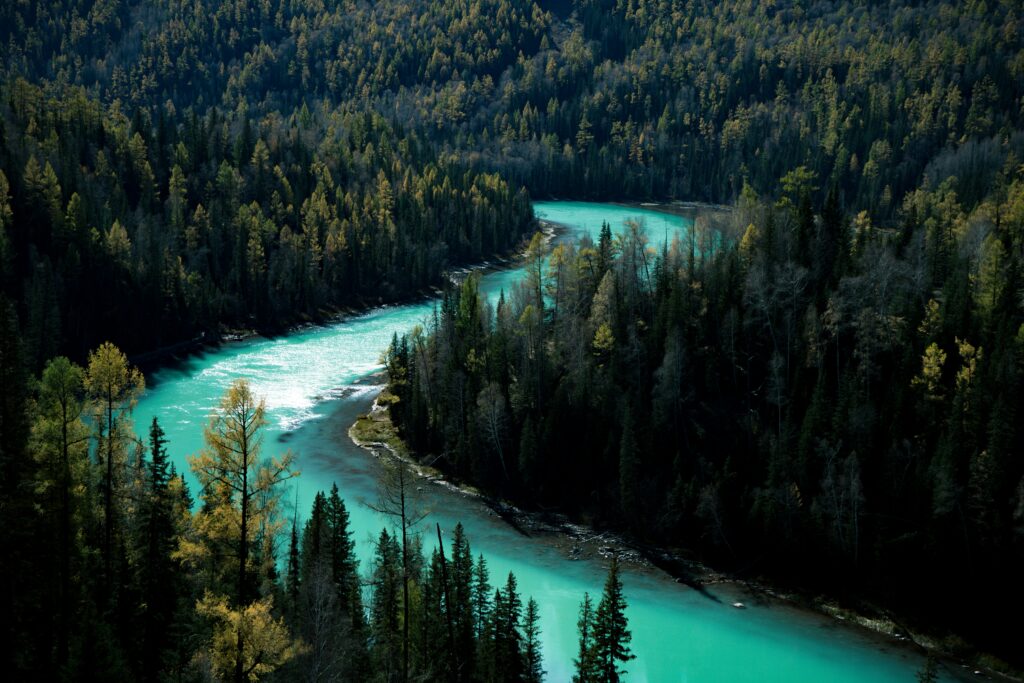
人间仙境——喀纳斯 The Fairyland – Kanas / Photo by Juniper Photon
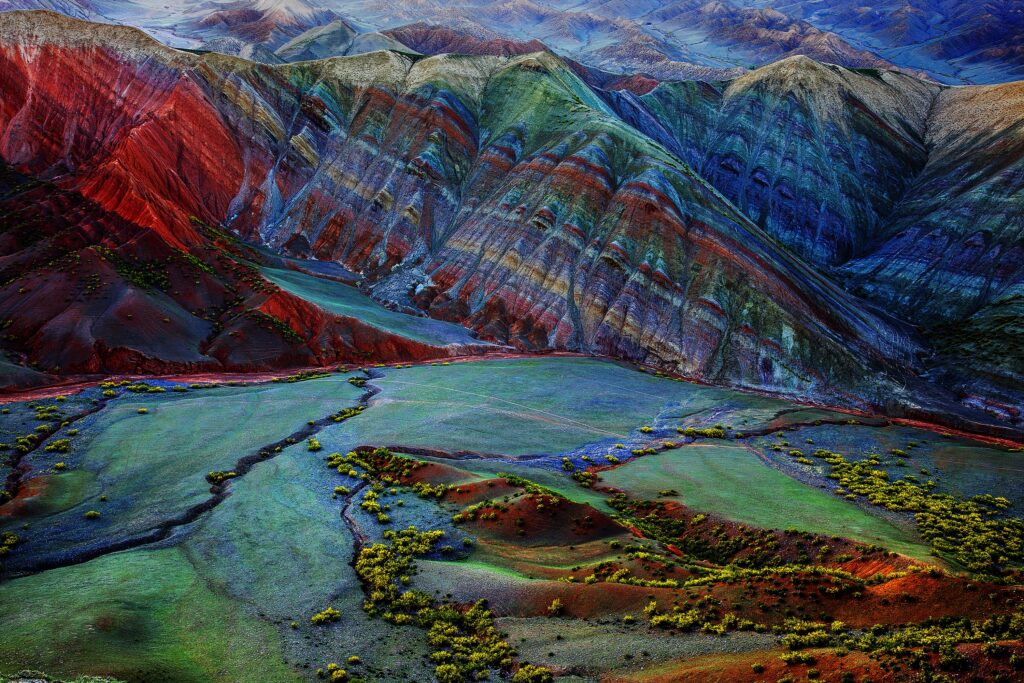
努尔加大峡谷 Nuerjia Canyon
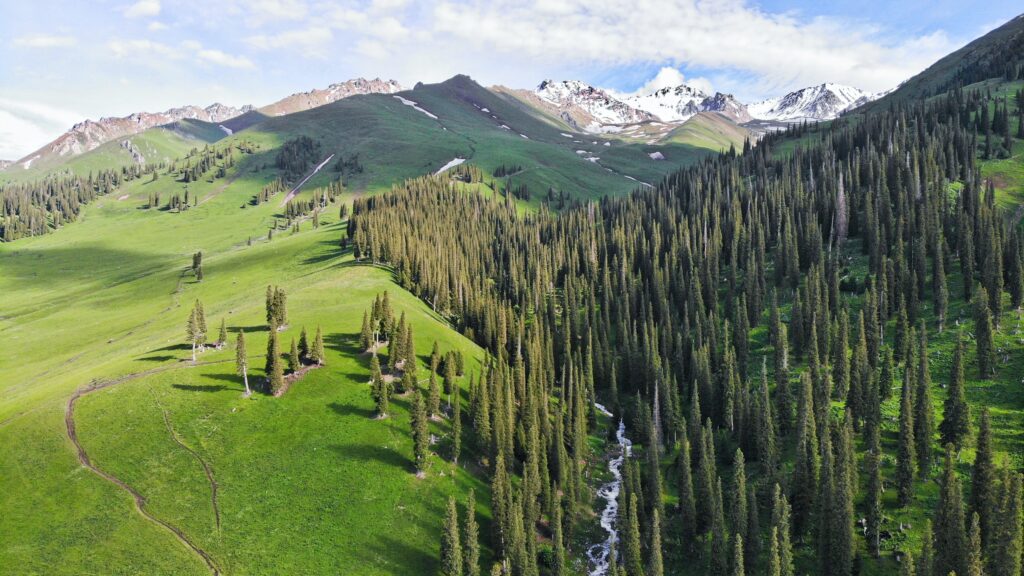
空中草原——那拉提 Sky Prairie – Nalati Grassland / Photo by Andy Guan
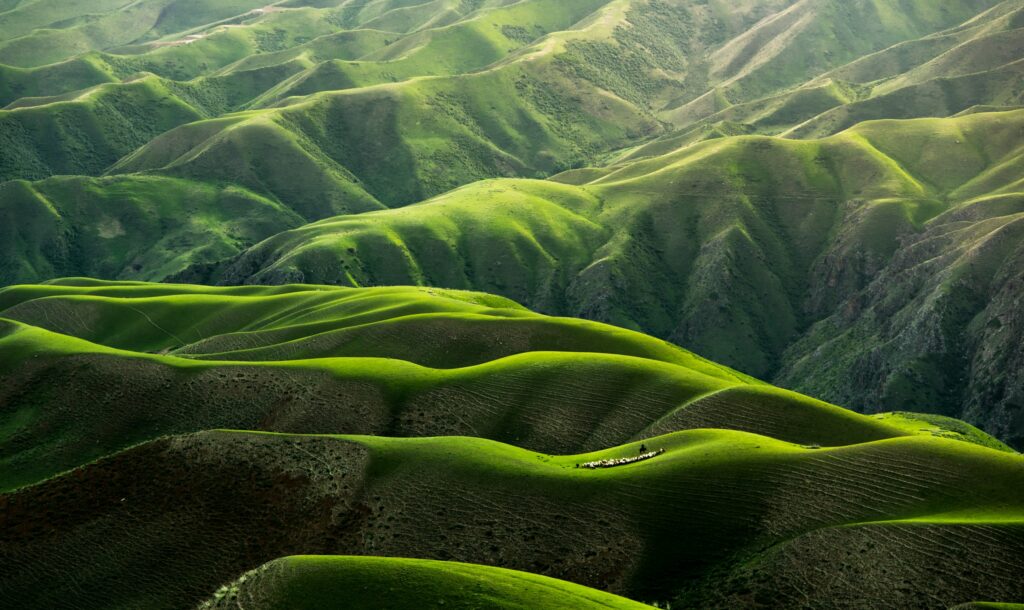
人体草原——喀拉峻 Body-shaped Prairie – Kalajun Grassland / Photo by Qingbao Meng
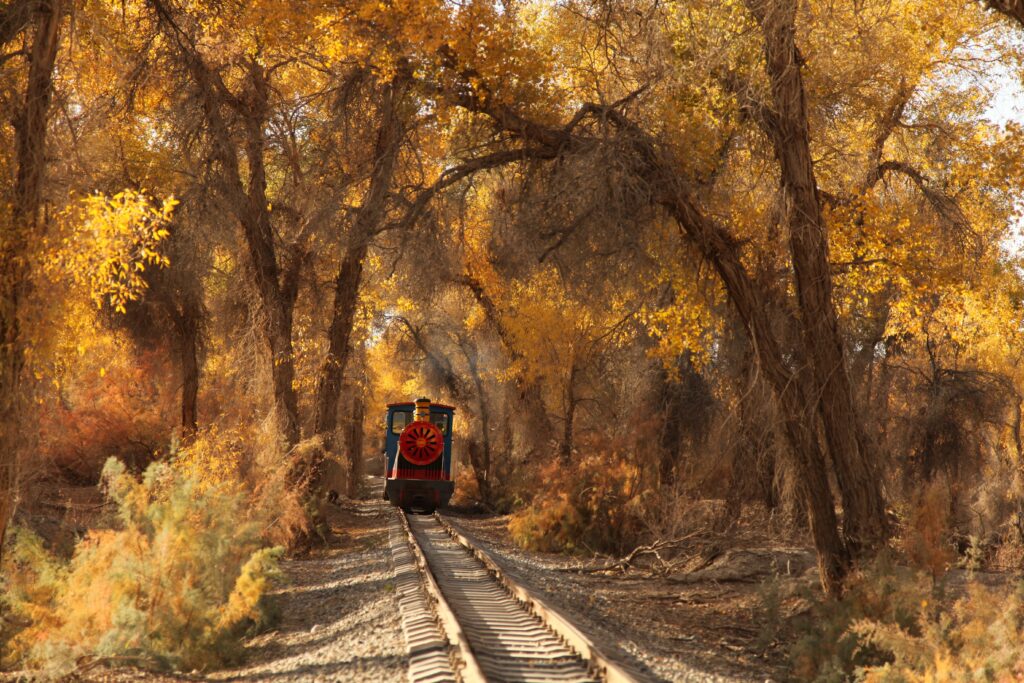
巴州胡杨林公园 Tarim Populus Euphratica National Forest Park
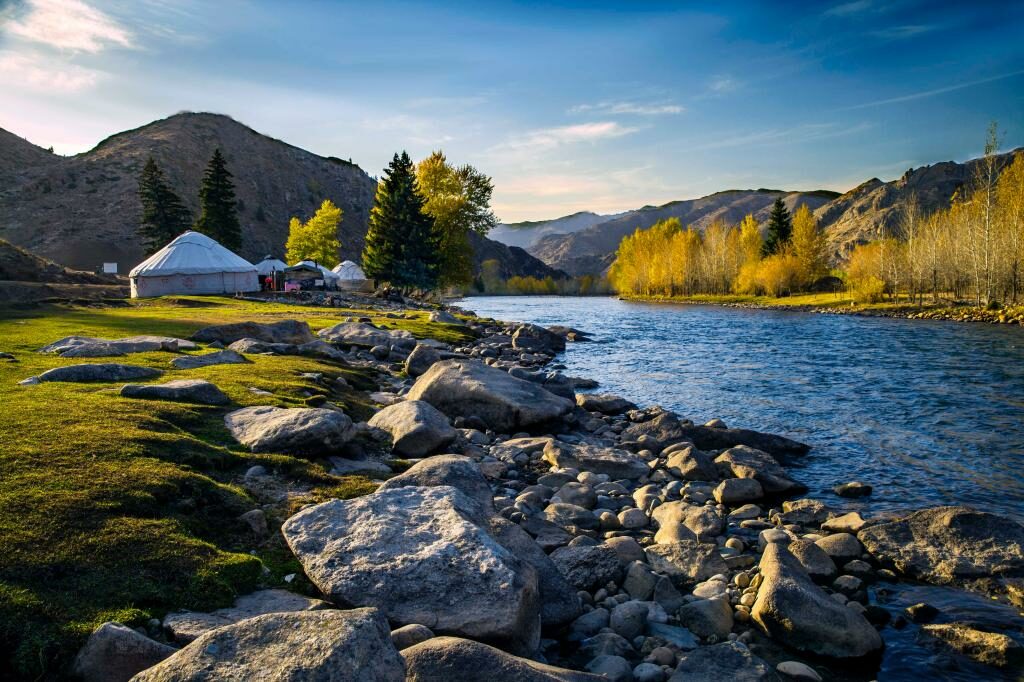
可可托海国家地质公园 Keketuohai National Park, Altay
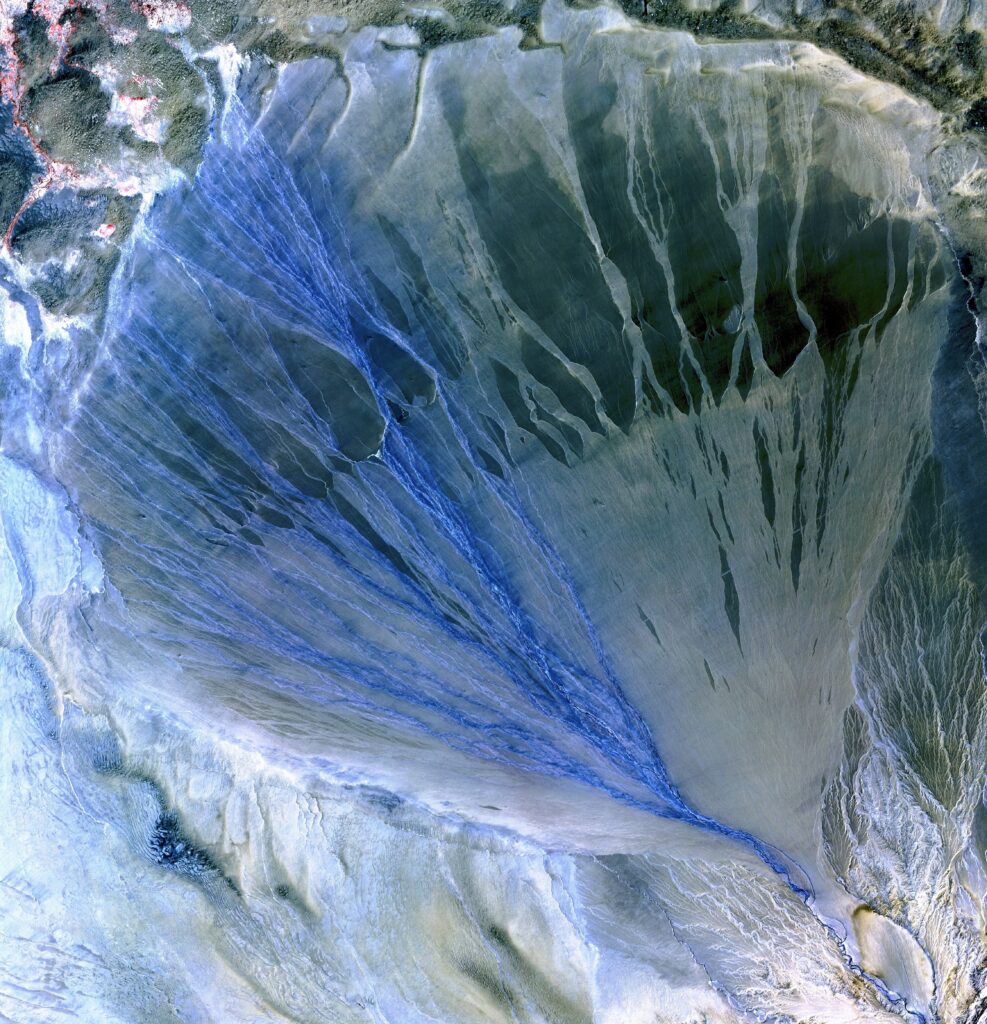
冲积扇 昆仑-阿尔金山 Alluvial Fan, Kunlun – Altun Mountains / Photo by USGS

阿勒泰市小东沟 Xiaodonggou Forest Park, Altay
世界自然遗产
World Natural Heritage
新疆天山
Xinjiang Tianshan
(2013)
新疆天山,即天山山脉东段,包括托木尔峰(阿克苏地区)、喀拉峻-库尔德宁(伊犁哈萨克自治州)、巴音布鲁克(巴音郭楞蒙古自治州)、博格达(昌吉回族自治州)4个片区。新疆天山具有独特的地质奇观和自然美景,从红层峡谷到山地冰川,从原始森林到河流湖泊,与相邻的沙漠景观形成强烈反差,将炎热与寒冷、干旱与湿润、荒凉与秀美、壮观与精致奇妙地汇集在一起,展现了独特的自然美。新疆天山的地形地貌和生态系统自上新世延续至今,完美体现温带干旱气候区生物生态演进过程。典型的山地垂直自然带谱、南北坡景观差异和植物多样性,展现了帕米尔—天山山地生物生态演进过程。新疆天山具有丰富的生物多样性,是众多珍稀濒危物种、特有物种的重要栖息地。
Xinjiang Tianshan, or the eastern portion of the Tianshan mountain range, comprises four components – Tomur, Kalajun-Kuerdening, Bayanbulak and Bogda. Xinjiang Tianshan presents unique physical geographic features and scenically beautiful areas – from red bed canyons to glacier-capped peaks, from undisturbed forests and meadows to clear rivers and lakes. These landscapes contrast with the vast adjacent desert landscapes, creating a striking visual contrast between hot and cold environments, dry and wet, desolate and luxuriant, majestic and delicate. The landforms and ecosystems of the site have been preserved since the Pliocene epoch and present an outstanding example of ongoing biological and ecological evolutionary processes in a temperate arid zone. Altitudinal vegetation distributions, significant differences between north and south slopes, and diversity of flora, all illustrate the biological and ecological evolution of the Pamir-Tian Shan Highlands. Xinjiang Tianshan has outstanding biodiversity and is an important habitat for relic species, numerous rare and endangered species as well as endemic species.
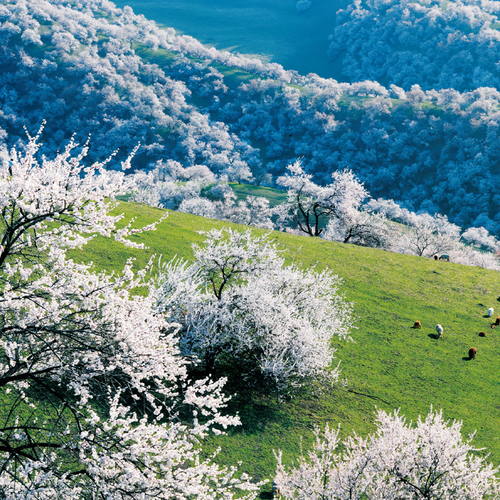
天山 Tianshan Mountains / UNESCO
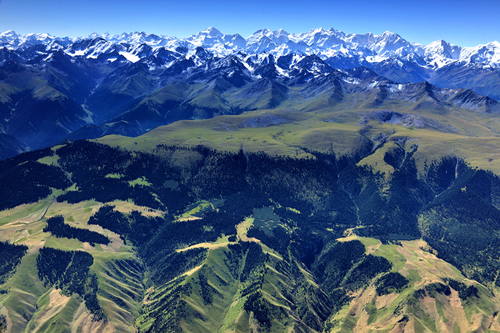
天山 Tianshan Mountains / UNESCO
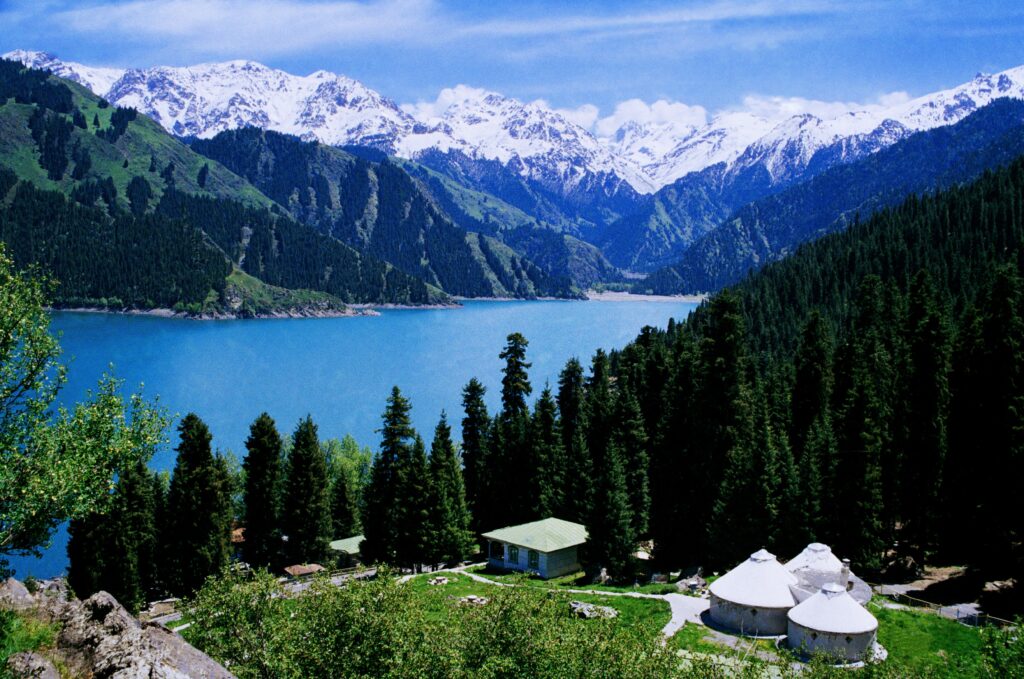
天山天池 Tianchi Lake, Tianshan Mountains
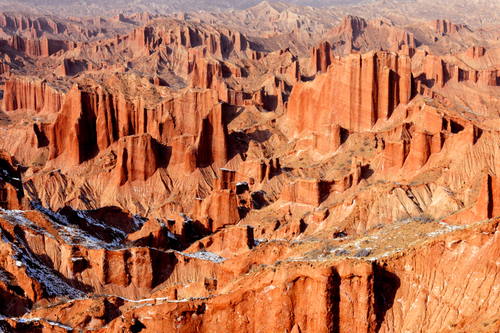
天山托木尔大峡谷 Tomur Grand Canyon, Tianshan Mountains / UNESCO
回溯历史
Back to History
新疆历史文化底蕴深厚,在5000多公里古”丝绸之路”的南、北、中三条干线上,分布着为数众多的古城、古文化遗址、古墓葬、石窟寺等人文景观。1900年,瑞典探险家斯文·赫定发现了新疆罗布泊地区的楼兰古城;1934年,瑞典考古学家沃尔克·贝格曼发现了楼兰附近的小河墓地,写下近现代考古史上的重要篇章。
Xinjiang enjoys a profound historical and cultural heritage. A significant number of ancient cities, cultural sites, tombs, grotto temples and other cultural landscapes are distributed along the three major routes of the Silk Road in the north, south and center. In 1900, Swedish explorer Sven Hedin discovered the ancient city of Loulan in Lop Nur, Xinjiang; in 1934, Swedish archaeologist Folke Bergman discovered the Xiaohe Cemetery near Loulan, adding an important chapter in modern archaeological history.
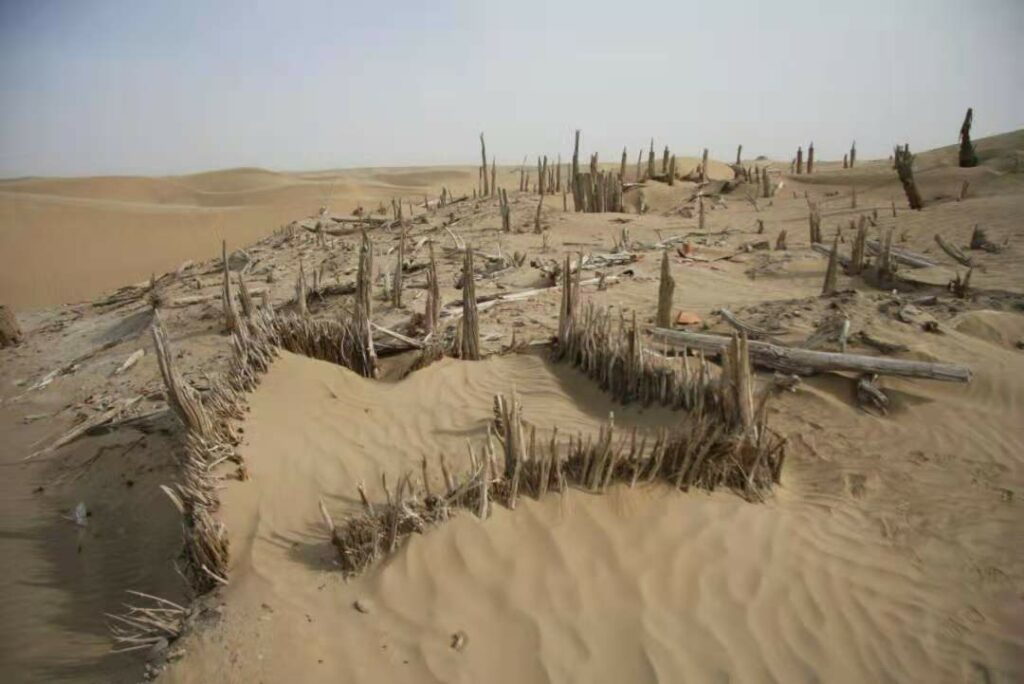
小河墓地 Xiaohe Cemetery / 新疆博物馆
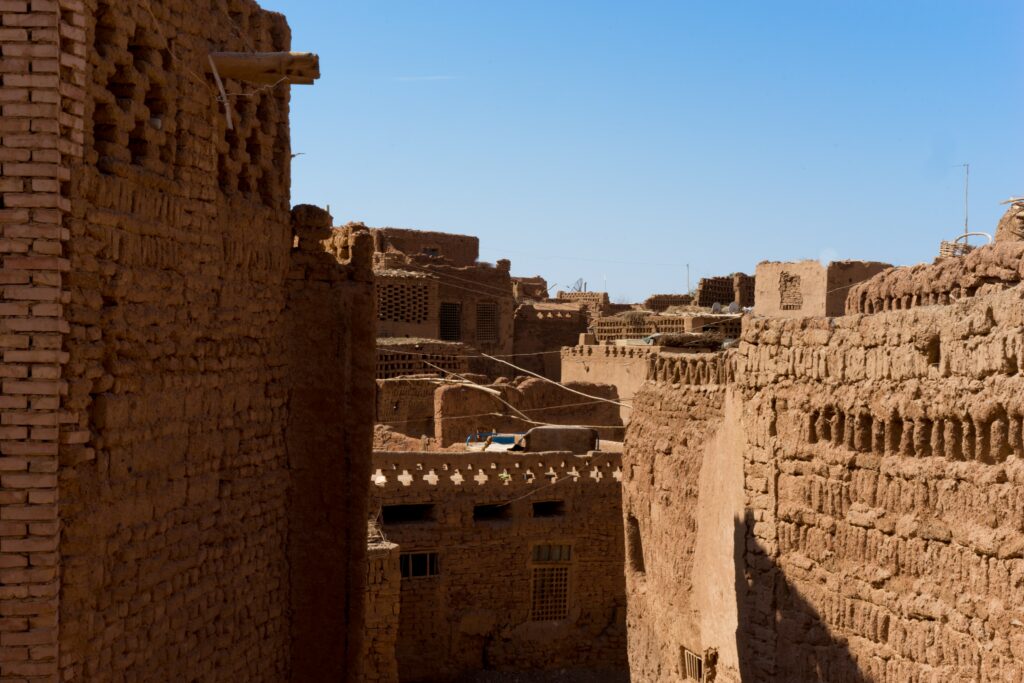
吐峪沟 Tuyuk / Photo by Lauren Barton

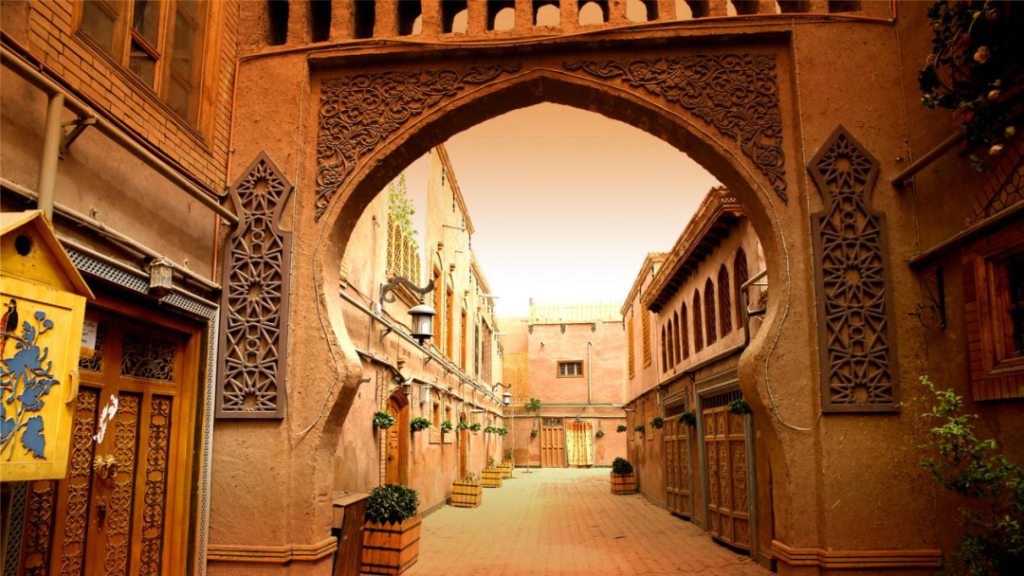
喀什古城 Ancient City of Kashgar
世界文化遗产
World Cultural Heritage
丝绸之路:长安—天山廊道路网
Silk Roads: the Routes Network of Chang’an-Tianshan Corridor
(2014)
丝绸之路促进了世界许多伟大文明的发展。2014年,中国、哈萨克斯坦、吉尔吉斯斯坦三国联合申报的“丝绸之路:长安-天山廊道路网”成功列入联合国教科文组织《世界遗产名录》。这段路网始自中国汉唐古都长安(今西安市)和洛阳市,向西延伸至中亚的七河地区,跨越近5000公里,形成于公元前2世纪至公元1世纪,直至16世纪仍在使用,连接了多种文明地带、促进了东西方不同文明之间持续而广泛的商贸、宗教、科技、文化、艺术等交流活动,尤其是亚欧大陆上草原游牧文明与农耕/绿洲/畜牧定居文明的交流。此段路网涉及33处遗产点,包含了亚洲大陆上不同历史时期的诸多帝国或汗国的都城或宫城、中心城镇、商贸聚落或城镇、佛教石窟寺、古道、驿站、关隘、烽燧、长城、城堡、墓葬等考古遗址和多种宗教建筑与遗存,其中位于新疆的有北庭故城遗址、交河故城、高昌故城、苏巴什佛寺遗址、克孜尔石窟、克孜尔尕哈烽燧等六个遗产地。
The Silk Road contributed to the development of many of the world’s great civilizations. In 2014, “Silk Roads: the Routes Network of Chang’an-Tianshan Corridor” applied by China, Kazakhstan and Kyrgyzstan was inscribed on the World Heritage List. This property is a 5,000 km section of the extensive Silk Roads network, stretching from Chang’an (present-day Xi’an) and Luoyang, the central capital of China in the Han and Tang dynasties, to the Zhetysu region of Central Asia. It took shape between the 2nd century BC and 1st century AD and remained in use until the 16th century, linking multiple civilizations and facilitating far-reaching exchanges of activities in trade, religious beliefs, scientific knowledge, technological innovation, cultural practices and the arts between various cultural regions, especially the nomadic steppe and settled agrarian/oasis/pastoral civilizations on the Eurasian continent. Thirty-three sites along the corridor include capital cities and palace complexes of various empires and Khan kingdoms, trading settlements, Buddhist cave temples, ancient paths, posthouses, passes, beacon towers, sections of the Great Wall, fortifications, tombs and religious buildings. Six sites are located in Xinjiang, including Beshbalik City Ruins, Jiaohe Ruins, Gaochang Ruins, Subash Buddhist Temple Ruins, Kizil Caves and Kizil Kagha Beacon Tower.
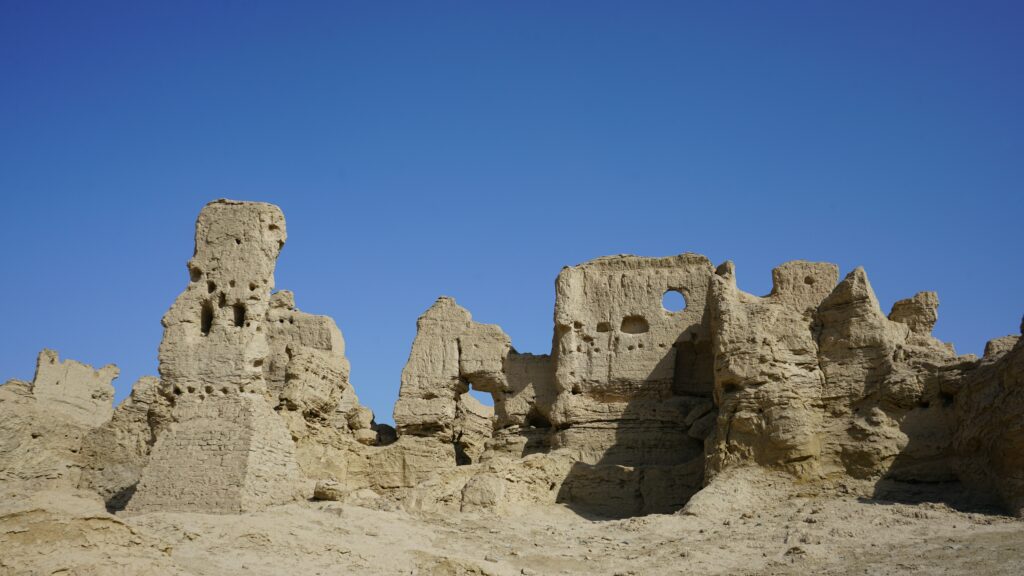
交河故城 Jiaohe Ruins / Photo by Darmau Lee
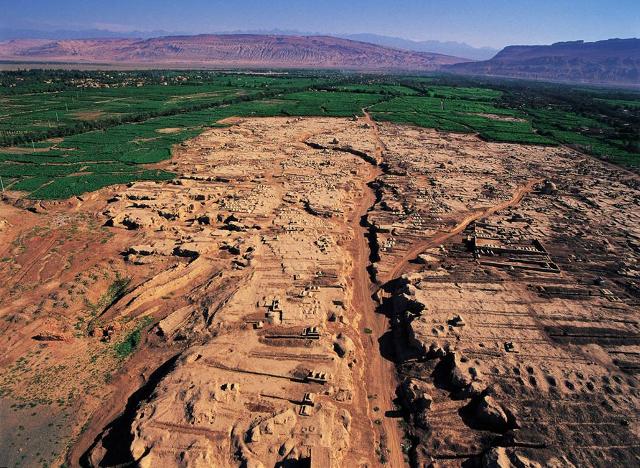
高昌故城 Gaochang Ruins
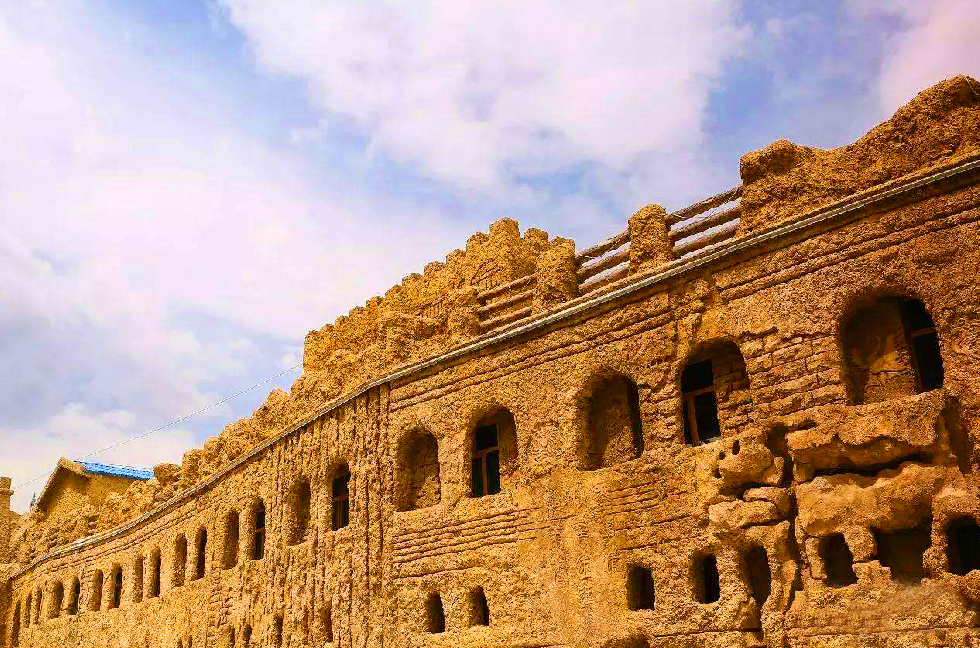
北庭古城遗址 Beshbalik City Ruins
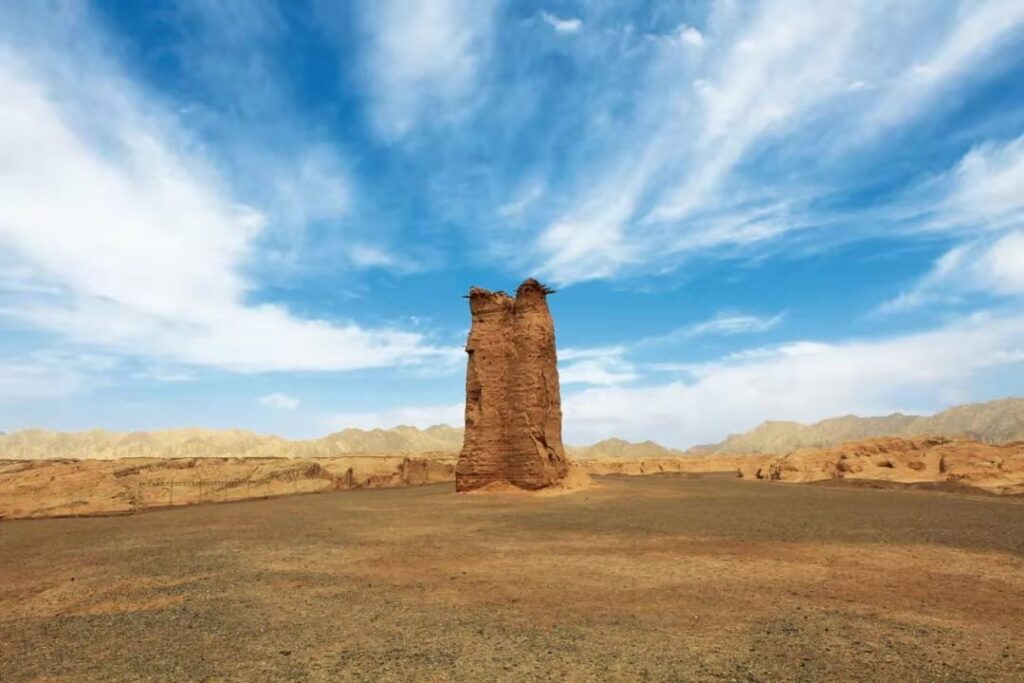
克孜尔尕哈烽燧 Kizil Kagha Beacon Tower
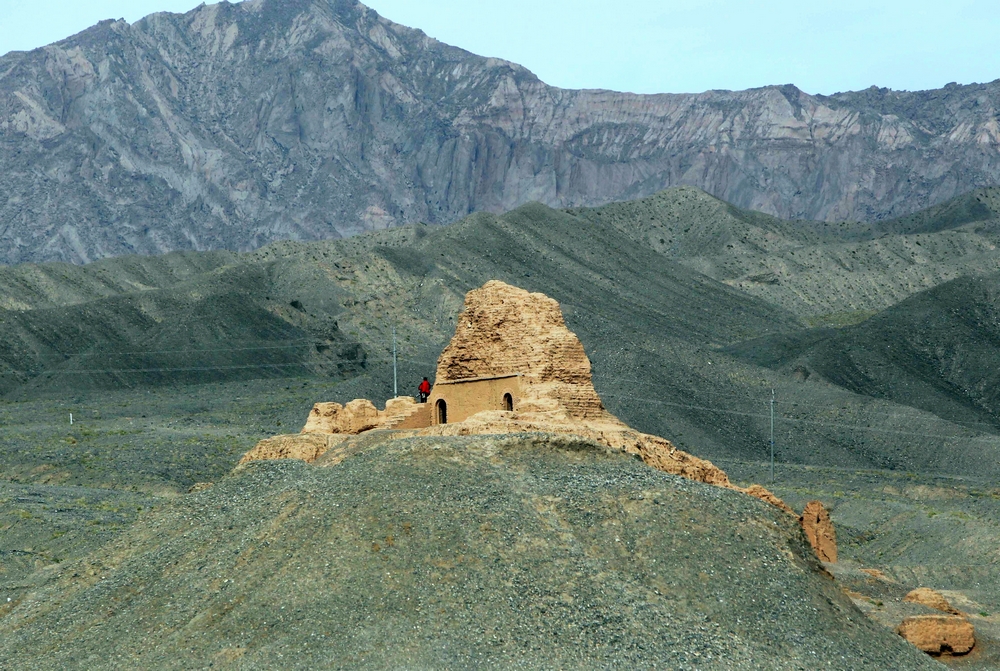
苏巴什佛寺遗址 Subash Buddhist Temple Ruins
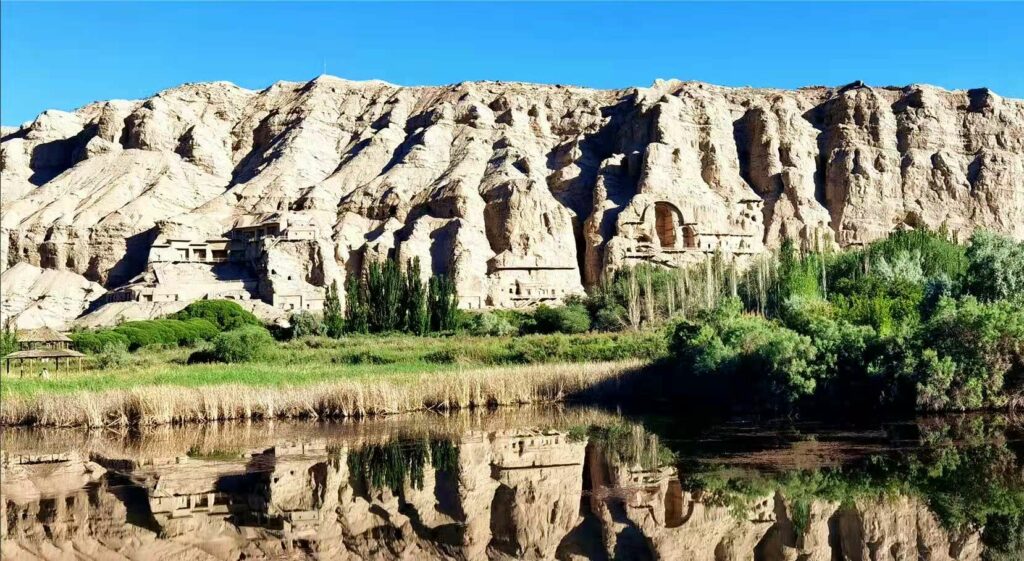
克孜尔石窟 Kizil Caves
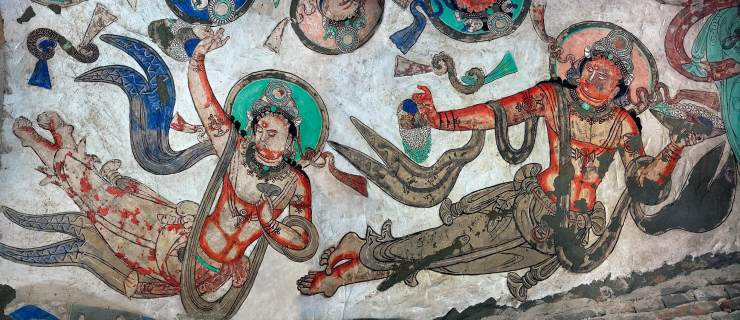
克孜尔石窟壁画 Mural in Kizil Caves
多彩生活
Embrace Colorful Life
新疆民族风情浓郁,各民族在文化艺术、体育、服饰、饮食习俗等方面各具特色。新疆素有”歌舞之乡”美称,维吾尔族的赛乃姆、刀郎舞,塔吉克族的鹰舞,蒙古族的沙吾尔登舞等民族舞蹈绚丽多姿。
Xinjiang is rich in ethnic culture with diverse ethnic groups featureing different customs, arts, sports, costumes, cuisines, etc. Xinjiang is known as the “land of singing and dancing” where Sanam and Dolan dances of the Uyghur, Eagle dance of the Tajik, Sauurdin dance of the Mongolian and a variety of folk dances bloom.
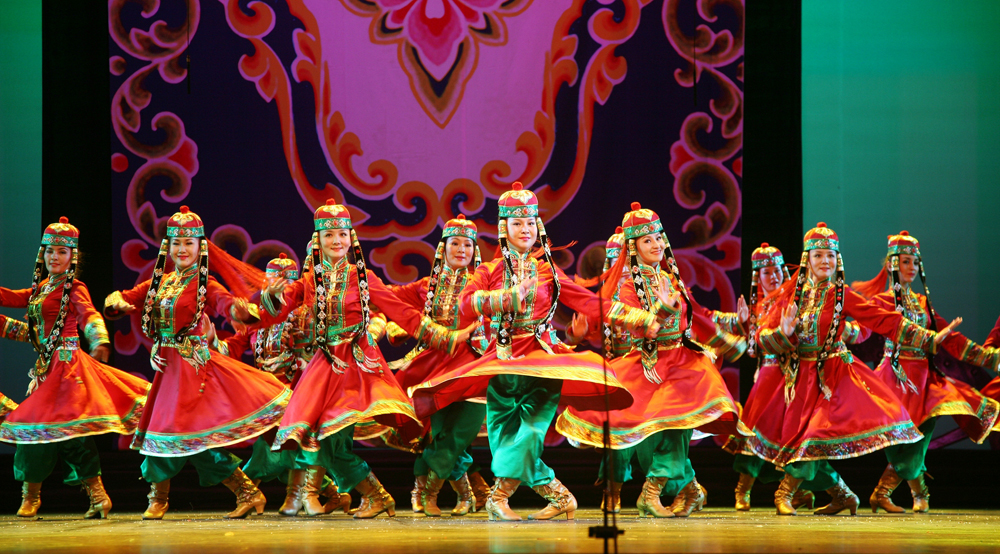
蒙古族萨吾尔登 Mongolian Sauurdin Dance / 刘晓辉 Liu Xiaohui www.zgysyjy.org.cn
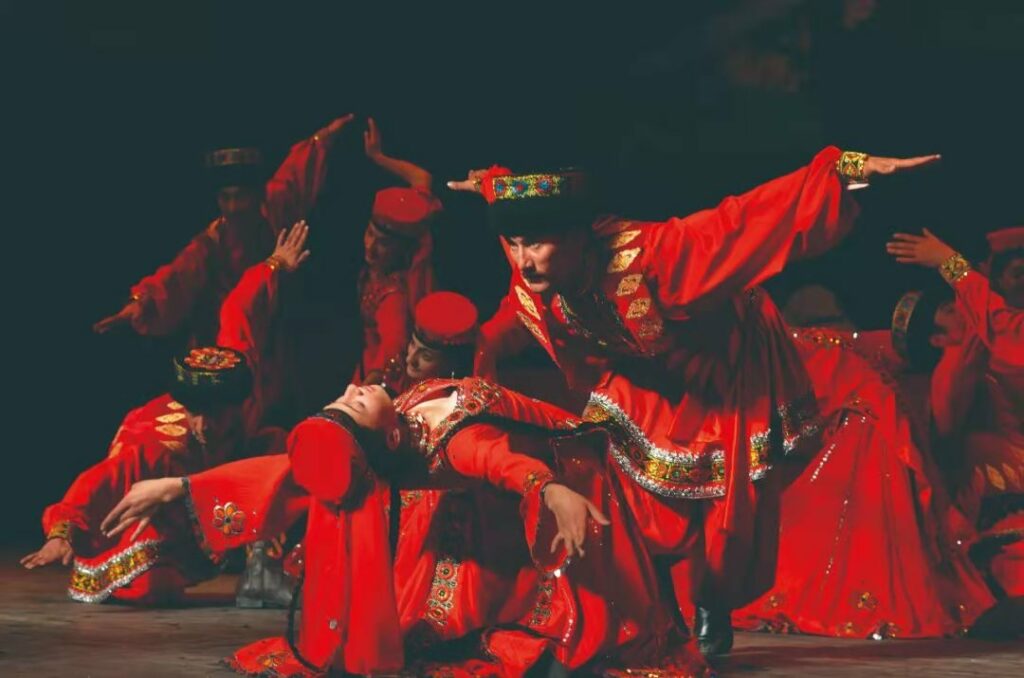
塔吉克族鹰舞 Tajik Eagle Dance
世界非物质文化遗产
World Intangible Cultural Heritage
新疆维吾尔木卡姆艺术
Xinjiang Uyghur Muqam
(2010)
木卡姆最初意为“古典音乐”,后逐渐发展为一种结合音乐、舞蹈、文学、说唱和戏剧等多种形式的综合艺术,因其丰富多样的内容、舞蹈形式、音乐风格和乐器种类而独具特色。新疆维吾尔木卡姆主要包括十二木卡姆、刀郎木卡姆、吐鲁番木卡姆、哈密木卡姆等四种风格流派。维吾尔族人民将历史、诗歌、英雄故事、哲人箴言和民间故事等融入木卡姆的唱词中,因此,木卡姆也被称为维吾尔民族生活和社会风貌的“百科全书”。
“Muqam” originally meant “classical music”, which gradually developed into an integrated art form including music, dance, literature, narrative, singing and opera characterized by diversity of content, choreography, musical styles and instruments. The Xinjiang Uyghur Muqam has developed four main regional styles, namely the Twelve Muqam, Dolan Muqam, Turpan Muqam and Hami Muqam. The lyrics contain Uyghur history, poems, sagas, proverbs, folk narrative, etc. Thus, Muqam is also called the “encyclopedia” of the life and society of Uyghur ethnic group.
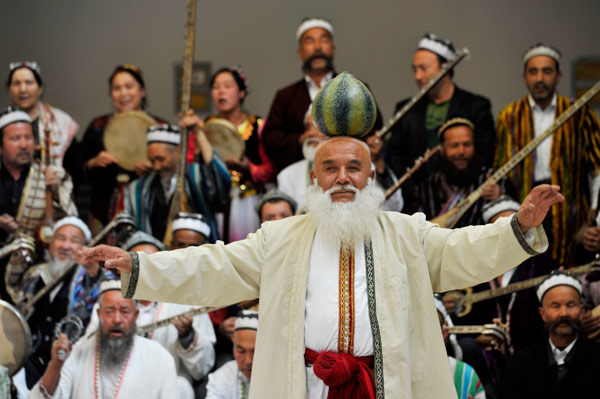
木卡姆 Muqam / Xinhua
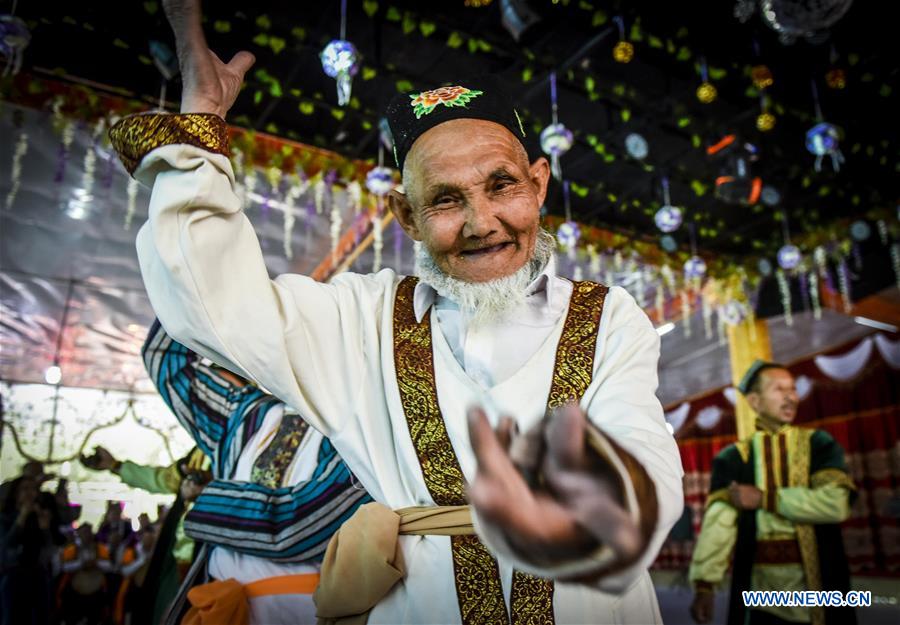
木卡姆 Muqam / Photo by Jin Wei Asianewsphoto
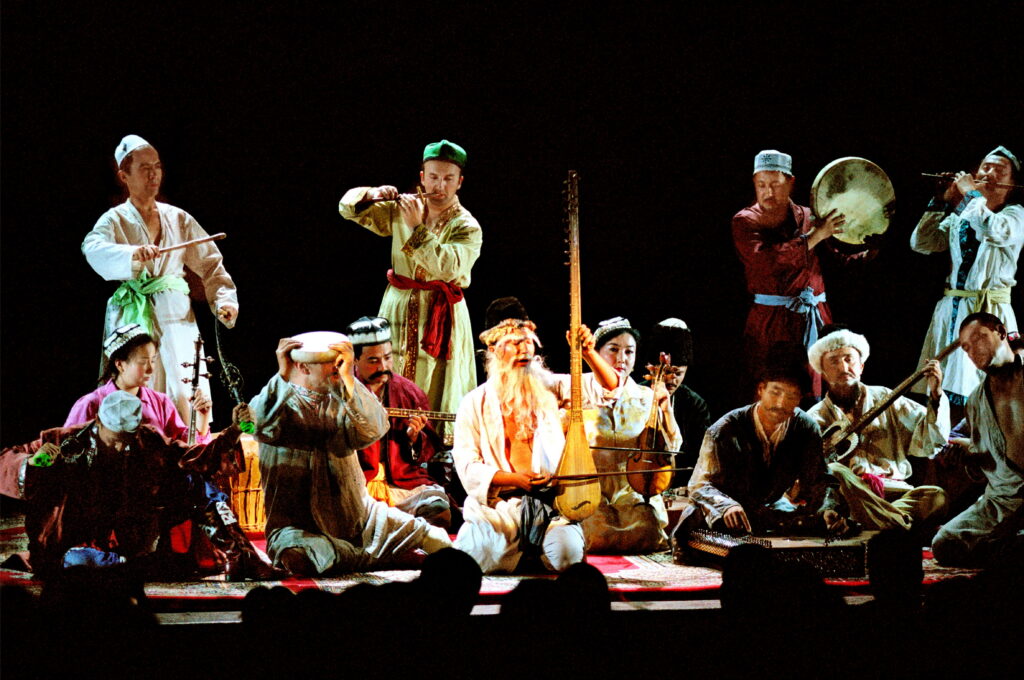
木卡姆 Muqam / www.ihchina.cn
世界非物质文化遗产
World Intangible Cultural Heritage
麦西热甫
Meshrep
(2010)
在中国新疆维吾尔自治区的维吾尔民族中间,流传着麦西热甫。麦西热甫是维吾尔人民文化传统的最为重要的承载者。完整的麦西热甫活动包括一系列丰富的习俗和表演艺术,如音乐、舞蹈、戏剧、民间艺术、杂技、口头文学、饮食及游戏。人们身着炫目的民族服饰,弹奏着当地的特色乐器,唱着祖辈传下来的歌谣,摆动起优美的舞姿,一起加入这场欢腾的盛会。
Found among the Uyghur people concentrated largely in China’s Xinjiang Uyghur Autonomous Region, Meshrep constitutes the most important cultural carrier of Uyghur traditions. A complete Meshrep event includes a rich collection of traditions and performance arts, such as music, dance, drama, folk arts, acrobatics, oral literature, foodways and games. People wear beautiful national costumes, playing the typical local instruments, singing traditional songs and dancing elegantly together in this jubilant gala.
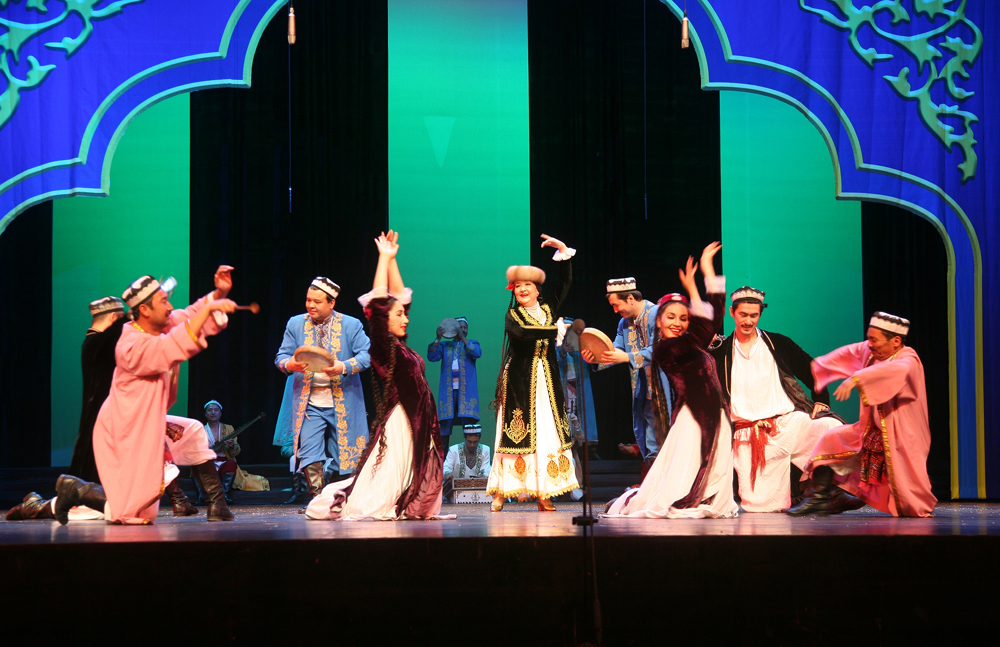
麦西热甫 Meshrep / 刘晓辉 Liu Xiaohui www.zgysyjy.org.cn
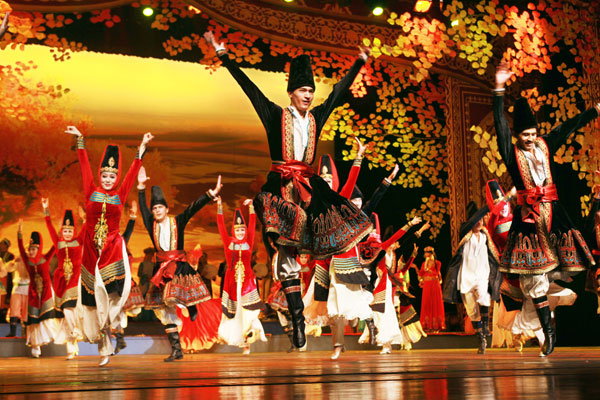
《永远的麦西热甫》Forever Meshrep choreographed by Dilnar Abdulla / China Daily
资料来源 / Sources:
新疆维吾尔自治区文化和旅游厅
http://xinjiang.gov.cn
中国国家地理
China Daily
chinaculture.org
https://en.unesco.org/
http://www.ihchina.cn
http://www.zgysyjy.org.cn
http://www.travelchina.org.cn/
《非物质文化遗产在中国》,2017
Facebook: China Cultural Center in Stockholm
https://www.facebook.com/China-Cultural-Center-in-Stockholm-110983273921638
Instagram: chinaculturalcenterinstockholm
https://www.instagram.com/chinaculturalcenterinstockholm/
Tik Tok: cccinstockholm
@cccinstockholm
Wechat: 斯德哥尔摩中国文化中心 or scan the QR code below

